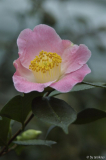Hallo Jens und JuleHab mir gedacht, vielleicht kann das Camellia-Register zur Klärung beitragen.Auf jeden Fall gibt es beide Sorten, identisch dürften sie also nicht sein.
Chûbu-tsukimiguruma (Chûbu Moon Viewing Carriage)(C.japonica)Encyclopedia of Camellias in Colour, vol.1, 1972, p.50, pl.38, description, p.296; Seibundô Shinkôsha, 1979, Senchinshû p.96 & p.230; Satô, 1975, Chûbu no Tsubaki, p.74, erroneously as Tsukimiguruma:
Medium size, 8-9 cm across, single pink, with colour softening to white towards the centre; 5-7 large, rounded, reflexed petals with their tips becoming deep pink, surrounding a large, spreading stamen cluster, in a ring form, with yellow filaments and anthers. Blooms mid-season. The flower is somewhat Higo like in form. Large, lanceolate to ellipic, flat, dark green leaves with well defined venation, long tapered apex and serrulate margin. Habit is erect and bushy. An old variety grown at the Higashiyama Botanic Gardens, Nagoya City, Japan, believed to be synonymous with the old Edo cultivar, Tsukimi-guruma, (Kamegorô, 1859), which is one of the Sanzuma" three spouses with Yukimiguruma and Hanamiguruma, implying that these varieties were loved as if they were wives, by the ancient camellia growers. See Yokoyama & Kirino, 1989, Nihon no Chinka, p.128, 129, colour photo. Synonyms: Goshozakura and Tsukimiguruma-Nagoya.
Tama-ikari (Jewelled Anchor)(C.japonica)Andoh, 1971, Tsubaki, Meika no Shôkai to Saibai, p.210 as Tamaikari:
Medium size, pink, single with colour fading to near white at base of petals, open- ing wide cup-shaped. Petals 6-7, emarginate with somewhat wavy margins; stamens cluster, spreading, circular. Anthers brownish-yellow, filaments white, fragrant. The seed pod of this variety opens in an anchor shape, hence its name. Originated in Kumamoto Prefecture, Japan by Ôta, Tsuguo and named by Adachi, Chôka in 1964. A seedling of Nioi-fubuki. See colour photos & descriptions: Encyclopedia of Camellias in Colour, vol.I, 1972, pl.36, p.49 & p.296; Seibundô Shinkôsha, 1979, Senchinshû, pp.89, 227. Yokoyama & Kirino, 1989, Nihon no Chinka, p.138. Erroneously listed as a Higo by SCCS., Camellia Nomenclature, 1984. Corrupted name: Tamai Kari. Chinese synonym: Yumao.Ich habe sie auch verschieden in Erinnerung, finde aber derzeit nur ein Bild der Tama ikari.

LG, Barbara





